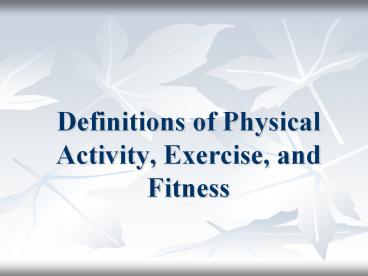Definitions of Physical Activity, Exercise, and Fitness - PowerPoint PPT Presentation
1 / 8
Title:
Definitions of Physical Activity, Exercise, and Fitness
Description:
... Activity, Exercise, and Fitness. Physical Activity ... Muscle-fitness. ... Common forms of muscle fitness exercise include isokinetic, isometric, and isotonic. ... – PowerPoint PPT presentation
Number of Views:118
Avg rating:3.0/5.0
Title: Definitions of Physical Activity, Exercise, and Fitness
1
Definitions of Physical Activity, Exercise, and
Fitness
2
Physical Activity
- The term physical activity describes many
forms of movement, including activities that
involve the large skeletal muscles. - Activities that involve the small skeletal
muscles (e.g. playing board games, drawing,
writing) are important, but they do not provide
the health benefits of activities that involve
the large skeletal muscles and require
substantial energy expenditure.
3
Physical activity is defined by its duration,
intensity, and frequency
- Duration is the amount of time spent
participating in a physical activity session - Intensity is the rate of energy expenditure
- Frequency is the number of physical activity
sessions during a specific time period (e.g. one
week).
4
Types of Physical Activity
Aerobic - light to vigorous-intensity physical activity that requires more oxygen than sedentary behavior and thus promotes cardiovascular fitness and other health benefits (e.g., jumping rope, biking, swimming, running playing soccer, basketball, or volleyball). Anaerobic intense physical activity that is short in duration and requires a breakdown of energy sources in the absence of sufficient oxygen. Energy sources are replenished as an individual recovers from the activity. Anaerobic activity (e.g., sprinting during running, swimming, or biking) requires maximal performance during the brief period.
Lifestyle physical activity typically performed on a routine basis (e.g., walking, climbing stairs, mowing or raking the yard), which is usually light to moderate in intensity. Physical activity play play activity that requires substantial energy expenditure (e.g., playing tag, jumping rope). Play activity with flexible rules, usually self-selected, for the purpose of having fun.
Sports physical activity that involves competition, scorekeeping, rules, and an outcome that cannot be predetermined. There are two categories of sports individual and team. Weight-bearing physical activity that requires people to move their own weight.
5
Exercise
- Exercise consists of activities that are planned
and structured, and that maintain or improve one
or more of the components of physical fitness. - Physical activity suggests a wide variety of
activities that promote health and well-being. - Exercise is often associated with fitness
maintenance or improvement only.
6
Types of Exercise
Calisthenics. Isotonic muscle-fitness exercise that overloads muscles by forcing the muscles to work at a higher level than usual. Flexibility (Stretching). Exercise designed to stretch muscles and tendons to increase joint flexibility or range of motion. Specific flexibility exercises need to be done for each part of the body.
Isokinetic. Muscle-fitness exercise in which the amount of force equals the amount of resistance, so that no movement occurs. Isotonic. Muscle-fitness exercise in which the amount of force exerted is constant throughout the range of motion, including muscle shortening (concentric contractions), and muscle lengthening (eccentric contractions).
Muscle-fitness. Exercise designed to build muscle strength and endurance by overloading the muscles also called progressive resistance exercise (PRE). Common forms of muscle fitness exercise include isokinetic, isometric, and isotonic.
7
Fitness
- Participating in physical activity is beneficial
to people of all ages. Physical activity
contributes to fitness, a state in which peoples
health characteristics and behaviors enhance the
quality of their lives.
8
Types of Fitness
Physical fitness A set of physical attributes related to a persons ability to perform physical activity successfully, without undue strain and with a margin of safety. Health-related physical fitness A physiological state of well-being that reduces the risk of hypokinetic disease a basis for participation in sports and a vigor for the tasks of daily living. Components include cardio-respiratory endurance, muscle strength endurance, flexibility, and body composition. Skill-related physical fitness Common components of physical fitness (e.g., agility, balance, coordination, speed, power, reaction time) that enable participation in sports and other physical activities also called performance or motor fitness.































